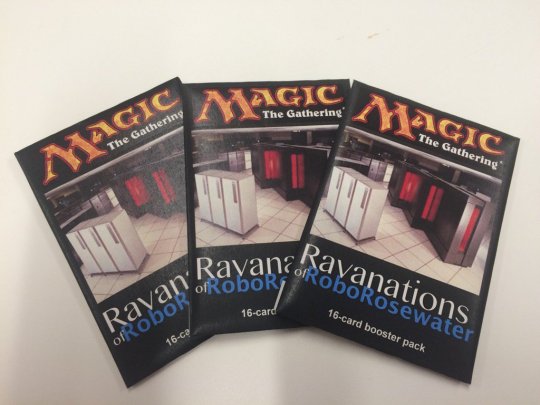
I love, love, love the RoboRosewater Twitter account. It brought me back into Magic after a 18 year hiatus. Most of the cards are hilarious gibberish, some are playable or near-playable, and some few are both playable and novel cards. After following the RoboRosewater account for a long time, I decided to build a draft set out of the cards from or derived from RoboRosewater cards. How hard could that be?
Read on to find out.
I don’t know Magic particularly well. This is my third ever Magic draft. I would rate my skill somewhere between “RTFM” and “lol.” I still get confused about simple things like when you declare blockers vs assign damage. I still say “interrupt” all the time. If you are reading this to follow in my footsteps, be warned: here be dragons, lots of derp, and a bit of hherp too.
It’s misleading to call this a RoboRosewater draft due to how many changes I made. The more accurate way to describe this is a set heavily influenced by RoboRosewater. When I made changes, I kept the title of the card and tried my best to keep the spirit of the card intact. This draft set probably isn’t as wild or fun as a pure RoboRosewater draft set. If you want that, I highly recommend this instead:
Album's here: https://t.co/Msi6eqraDL and a pdf w/ correct scale: https://t.co/dZm2WF2TEB
— μ (@mu_is_a_letter) July 6, 2016
My goal in building this draft set was pretty simple. I wanted to make a set of cards that could be used in a mock draft (not a cube of singletons) under the following constraints:
My purpose with these constraints was to simulate a proper set, but also to allow people to unleash their inner planeswalkers. In a set with no deliberately designed archetypes or stragies, who in our group would be able to discover and exploit the most powerful synergies and decks?
I ended up having to make a number of tweaks as I went through this process. The primary cause is that not all cards are created equally. RoboRosewater makes green cards almost twice as often as black cards for instance - 39 total playable green cards vs 22 black cards when I last looked. It’s a similar story for types - 117 creatures vs just 51 sorceries, instants, and enchantments.
Because I wanted this to be a draft simulation, I also had to make costing changes to smooth out the mana curve for each color. I used the draft frequencies of Shadows over Innistrad as a starting point and came up with the following rough frequencies by rarity:
Furthermore I went with the following per-pack distributions:
A RoboRosewater draft wouldn’t be complete without a few playable but totally useless cards. I couldn’t bear the thought of leaving out good ol’ Racka Rornoshy for instance:

Since the power level of RoboRosewater seemed higher than “average” Magic, I repurposed mythic rares as mythic garbage instead.
Most changes were limited to costing, color changes, or cleaning up the text to conform to modern templating and fix minor illegalities/misunderstandings. I removed or altered mana abilities on creatures and permanents to ensure that any two-color combination was equally draftable. This meant that a creature or artifact never generates a color of mana that wasn’t required to cast it.
RoboRosewater loves to refer to tribal themes where it doesn’t generate many creatures within the tribe. I made every effort to fix those references so that no participant in the draft felt misled and every tribal power has a least a few members of that tribe in the draft.
I had to heavily edit a number of lands. RoboRosewater loves to generate lands that are pretty bonkers. For instance, here’s the original Wulder of Boon and Fire Sheap:

Neither is very compelling or sensible on their own, so I combined the spirit of Fire Sheap (land with consumable counters) and Wulder of Boon (land that can adjust p/t or generate mana) to create the final versions of those two cards that made the draft:

Finally, I made changes to extrapolate interesting keywords and effects that weren’t defined by the cards themselves. Joto of Same Uftine is a good example - Hherp is interesting enough that it should do something related to casting from hand…

After thinking a lot about what it meant to “cast a card from hand”, Joto became this:

(Joto also gained reach because green was desperately short of ways to deal with fliers)
Manduj Masthorow is another good example - what is “borest strike” exactly?

The idea for this definition didn’t even come from me but from one of the Twitter responses:
@RoboRosewater Borest Strike (this creature deals damage after creatures without borest strike)
— 马塞洛·乾酪 (@Lil_cheez) November 27, 2015
Thus, Manduj’s final form:

Thanks for bearing with me. I just wanted to make sure you understood the intent and constraints behind some of the cards that were changed.
All Commons, Uncommons, and Rares (imgur)
We are currently playtesting this draft set. I do not recommend putting together a draft of these cards at this time. Even just the initial draft revealed a few problems - Hydrobow Sunchaser is unintentionally overpowered as it can return itself from the graveyard. On the flipside, I took the original Fortigang Tramber and made it even worse, creating the least liked card in the draft.
At Braintree we turn drafts into “draft leagues” that run over the course of a couple of weeks. When this league finishes, I’ll post…
Finally, let me again express my gratitude to RoboRosewater by paraphrasing one of my favorite quotes:
If anything in this set brings you joy or fun, all of the credit is due to RoboRosewater. Only the mistakes are mine.
Please feel free to ask any questions you have about this via Twitter.

An extremely timely and focused list of books, games, movies, and miscellanea I enjoyed throughout 2023

I’m done with roleplaying deal alerts, but I’m still passionate about helping roleplayers find great games
With no particular order or structure, these are random things I’ve been enjoying lately